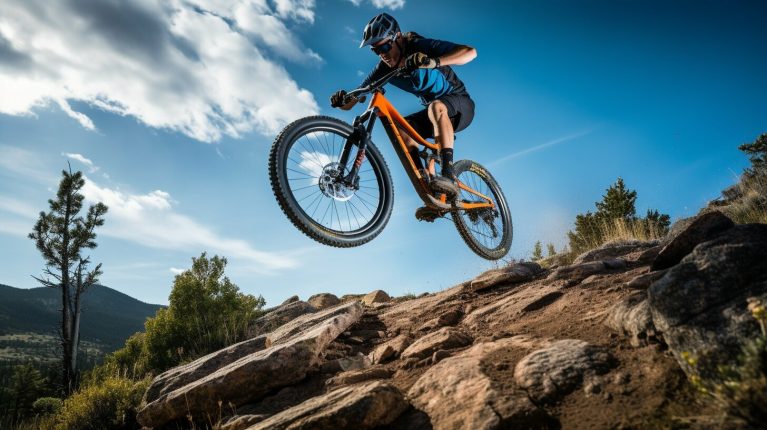Mountain biking isn’t just a sport; it’s a way of life for many, including myself being an avid mountain biker.
Am I great at mountain biking? No to at all, but I love to get out in the open, and it’s a great way to keep fit whilst participating in adventure, either on your own, with kids or with your friends.
Mountain Biking is about the thrill of the ride, the challenge of the trail, and the community that surrounds it.
Over the years the popularity of Mountain biking has and evolved increased substantially. Due to, in part, technological advancements that have made bikes more accessible and capable than ever before!
It is considered more now as a passion and is far more than just pedalling through backcountry trails.
It has evolved in a way that there are various forms of mountain biking from cross-country to downhill and freeride.
The Roots of Mountain Biking
The 1970s: The Birth of Modern Mountain Biking in California
Way back in the 1970s, a group of keen cyclists in County, California is where the roots of True Mountain Biking were laid.

It was in the 1970s, amidst the scenic landscapes of Marin County, California, that mountain biking truly found its footing.
Bringing a competitive edge to biking, they would challenge each other to downhill races, at the time they used what was known as modified “clunkers”, which would then later lead to the adventurous term of Mountain Biking.
Key Figures and Their Contributions to Mountain Biking
Pioneers in the mountain biking world include Gary Fisher, Joe Breeze, Tom Ritchey, and Keith Bontrager who were giants in evolving the sport. Joe Breeze, in particular, is credited with crafting the first mountain bike designed specifically for off-road use in 1977.
These innovators not only pushed the limits of what bikes could do but also laid the groundwork for the mountain biking culture and industry worth US$ 6.26 billion in 2022 with a projected growth 2% CAGR from 2023 to 2029, which by this time is forecast to rise US$ 13.86 billion by 2029.
The key reason why there has been such a boom with the increasing popularity in this sport is in part down to the health benefits, technological advancements and also this form of biking being seen as an adventure.
As a result of this book, it has also spawned mountain biking tourism, which is particularly popular in Wales and Scotland.
The 1980s: Mountain Biking Hits the Mainstream
Being an 80s child myself, I can remember bikes, especially BMX being a big thing at the time, I know those as my first bike was a yellow and blue BMX 🙂
However, I couldn’t help but envy my older friends having a mountain bike, which had gears!!

This inevitably lead to a pivotal moment for mountain biking as not only did it start to become cool, but it also went from a hobby to a mainstream sport.
Then the innovation started with the introduction of improved design for off-road use, featuring durable frames, wider tires, and advanced gearing systems.
The First Commercial Mountain Bikes
The 1980s marked a pivotal moment for mountain biking as it transitioned from a niche hobby to a mainstream sport. This era saw the introduction of the first commercial mountain bikes. Manufacturers began producing bikes specifically designed for off-road use, featuring durable frames, wider tyres, and advanced gearing systems. These innovations made mountain biking more accessible to the general public, fueling its popularity.

Mountain Biking Professional Competitions
Now that this relatively new sport is gaining traction in the 80’s, many professional mountain biking competitions have started to appear.
The formation of professional circuits and races, such as the National Off-Road Bicycle Association (NORBA), legitimized mountain biking as a competitive sport and attracted sponsors and media attention which then lead to the huge industry that it is today.
Media Coverage and Public Interest Spike
The increased media coverage of mountain biking competitions and the lifestyle then triggered even more appeal through Magazines, television specials, and even films began featuring mountain biking in them, highlighting the thrill and adventure of the sport.

This exposure captivated a wider audience and the age range attraction broadened, drawing more participants and spectators to the sport.
Ultimately the public interest in mountain biking soared, and there you have it, its place in mainstream sports culture was set and so was further growth and innovation over the up and coming decades, up to the present day.
Technological Advancements and Innovation
Evolution from “Clunkers” to Sophisticated Machines
By the term “Clunker” what this means is an old, heavy bike modified for off-road use, considered the prototype to modern mountain bikes. Compared to what you see today, even on the basic level, they are almost incomparable.
Todays mountain bikes can be very high-tech, with remarkable technological advancements
It is one thing making a bike light, weighing just grams!, but also sophisticated with gears, but it’s quite another to make it durable enough to maintain the terrain a mountain bike has to tackle, in all weathers, with ease to it is worth mentioning!
Key Developments: Suspension Systems, Frame Materials, and Braking Improvements
- Suspension Systems: One of the most significant advancements in mountain biking technology has been the development of suspension systems. I remember the first time I saw a bike with suspension, I couldn’t believe it had the same technology as a car! Early mountain bikes were rigid, but the introduction of front and full suspension systems has revolutionized the sport. These systems absorb shock, improving rider comfort and control over rough terrain.
- Frame Materials: The evolution of frame materials has played a crucial role in enhancing the performance of mountain bikes. From the heavy steel frames of the past which were often related to the so-called “clunkers”, manufacturers have moved to lighter and stronger materials like aluminium, carbon fibre, and titanium. This shift has resulted in bikes that are not only lighter but also more durable and responsive.
- Braking Improvements: The transition from rim brakes to disc brakes has provided riders with more reliable innovation and effective stopping power, crucial for the steep and unpredictable terrains of mountain biking.
Impact of Technology on the Sport’s Accessibility and Safety
These technological advancements have made mountain biking more accessible and safer for riders of all skill levels, whilst at the same time given pro bikers tools to excel and push themselves as human beings to break records, compete and become even better within their chosen sport.
Improved bike designs and features have lowered the entry barrier for beginners, while advanced riders benefit from enhanced performance and control.
Safety has significantly improved, with better suspension reducing the risk of injury and advanced braking systems allowing for precise speed control.
The Future of Mountain Biking in 2024 and Beyond
Emerging Trends and Technologies
The future of mountain biking looks bright, with continuous innovations shaping the sport. Mountain bikes will always continue to be improved upon, however now with the introduction of Electric mountain bikes (e-MTBs), this could be a completely new, different game-changing breed of bikes which is set to come through.
In my opinion I don’t think both bikes will necessarily compete against each other, but due to their different angles of approach to biking, will likely attract even more people to the sport, which is a great thing long term.
When it comes to using AI and other related technologies with mountain biking, yes even AI is getting in on the act! Virtual reality (VR) and augmented reality (AR) technologies are beginning to offer new training tools and immersive experiences for riders.

Environmental Considerations and Trail Sustainability
Its great that mountain biking popularity and participation is growing, however, with that there is also some level of responsibility required.
Minimizing its environmental impact, will be one of the key aspects of the longevity of the success in biking, especially in green areas or natural habitats, which let’s face it, offers the best type of biking ultimately, so we need to look after it!
There is already schemes underway in order to keep the best riding practices whilst participating in trail restoration projects to ensure that mountain biking remains environmentally friendly. So in regards to that the future is already here.
The Role of Community and Advocacy in Shaping the Future
Community and advocacy are at the heart of mountain biking’s future.
Local and global biking communities are encouraging more people to take up the sport. There are so many great things that Mountain Biking bring to the table, competition and health benefits being probably the main advantage.
As long as this is done in a responsible manner, such as looking after the trails and habitat Mountain biking is most enjoyed, then there appears to be a great future for the sport, both on an amateur level and also professionally.
Mountain Biking Support groups are working tirelessly to secure and expand access to trails, promote rider education, and ensure that mountain biking continues to thrive for all generations and for all levels of entry.
These efforts are crucial in navigating regulatory challenges and in making the sport more accessible and enjoyable for everyone.





